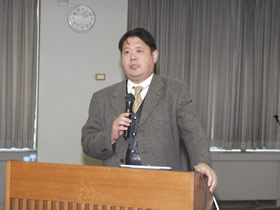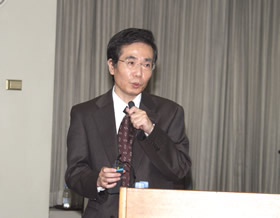|
|
 |
On November 9, 2004, at the Sun Sky Room in Otemachi, Chiyoda-ku, Tokyo, the 9th Manager Seminar was held for manager class employees of member companies, with about 90 persons attending. This seminar consisted of two lectures on the theme of “Learning from Major Accidents.” The lectures were of keen interest and will assist efforts for further improvement of the safety culture of member organizations.
|
|
Lectures
|
|

Mr. Okamoto
|
Opening remarks by NS Net Secretary-General Machida were followed by reports on the results of activities by Safety Department Director Kasai and Distribution Department Director Nishino. Next, Dr. Koichi Okamoto, Professor of Human Science at the Toyo Eiwa University , delivered a lecture entitled “Analysis of the JCO Accident and the Structure of Irresponsibility.” In so doing, he took up subjects including the particulars of the JCO accident, organizational background factors, the corporate culture (which had fallen into syndrome of chronic irresponsibility), and methods of overcoming problems.
In the lecture, he talked about:
? The factors behind the accident included the change in the work process, the discontinuation of orders for three and a half years and management rationalization with an emphasis on the working departments, resumption of work by new workers, and the lack of educational programs for these workers.
? Besides these, there was also a problem due to two-tiers of leadership, one consisting of symbolic leaders, and the other, of actual leaders. In addition, the decision-making mechanism had structural problems, and provisions for safety checks failed to function properly.
? Organizations that are liable to fall into the irresponsibility syndrome generally have a culture dominated by authoritarianism that attempts to pigeonhole everything in terms of a single principle, and the servile mentality that is one of its variant forms. Authoritarianism is composed of doctrinarianism, i.e., inflexible application of a dogma in all areas; conventionalism arising from unconditional conformance with precedents; and formalism, in which discussions of substance are squelched by form. Personal authoritarianism breeds an authoritarian culture, and only authoritarian-minded people adapted to this culture can survive in the organization. A vicious circle is set in motion, in that both the culture and procedures consequently become increasingly authoritarian. In decision-making, a servile mentality accords precedence to decision by an authority over decision based on the facts, and is common in Japan. In an excessively servile culture, the organization is liable to emphasize payability and deemphasize safety. Reduction of organizational violations requires correction of a servile culture.
? Psychological biases held by individuals can influence decision-making. As viewed from the organizational aspect, it is necessary to control the decision-making procedure.
Dr. Okamoto commented on these and other points while illustrating his remarks with reference to actual cases that deserve to be noted.
|

Mr. Kojima
|
Next, Mr. Shigeo Kojima, Manager of the Reliability Technology Group at Computer Software Development Co .,Ltd ,gave a lecture entitled "Lessons of the Columbia Accident and Safety Culture in Organizations." In it, he described the causes of the Columbia space shuttle disaster and the related organizational background while extracting lessons for Japan.
In the lecture, he talked about:
? The physical cause of the accident was a crack in the thermal protection system on the leading edge of the left wing caused by a falling piece of insulation. However, Mr. Kojima also cited organizational factors including organizational barriers that impeded the transmission of safety information while suppressing differences of technical view, the lack of an interdepartmental setup for comprehensive management of plans, and the existing of a decision-making process that was out of line with the organization rules.
? The accident underscored the need for understanding and improvement of the facts of the organizational and safety culture, the establishment of an independent scheme for safety assessment, and improvement of the transmission and utilization of risk information.
? Mr. Kojima also mentioned cases of good practice (learning from mistakes, encouraging expression of minority opinions, etc.) from the US Navy, and pointed out three requirements in approaches to construction of a safety-oriented culture in organizations: 1) democratization of a decision-making process and introduction of an independent safety technology unit, 2) checking of the organizational culture for elements that invite mistaken decisions, and 3) preparation and organization of capabilities for foreseeing and handling risks as opposed to after-the-fact response.
The questionnaire survey conducted after the lectures collected many views, including the following.
|
After the presentations, a survey was conducted and various opinions received such as those below.
Lecture by Dr. Okamoto, Professor of Toyo Eiwa Jogakuin
?While I have read various reports about the JCO accident, I think Dr. Okamoto's was excellent for its identification of problem points from the perspective of the organizational disposition.
? Thus far, I had regarded the report on the JCO accident investigation and its influence as involving nuclear power. Dr. Okamoto's lecture gave me a deep appreciation of the importance of the organizational culture and management at the top.
Lecture by Mr. Kojima of Computer Software Development Co .
? I found the lecture of value for its detailed look at NASA's activities and organization. I realized that, even at NASA, the very symbol of advanced technology, risk management and the decision-making process are not perfect. Mr. Kojima's remarks reconfirmed that safety culture, even in the field of nuclear power, still has a long way to go.
?Aside from the good examples from the Navy, I was particularly interested to learn that understanding of measures could be facilitated by using the word "risk" instead of "safety" in them. |
|
|
|







